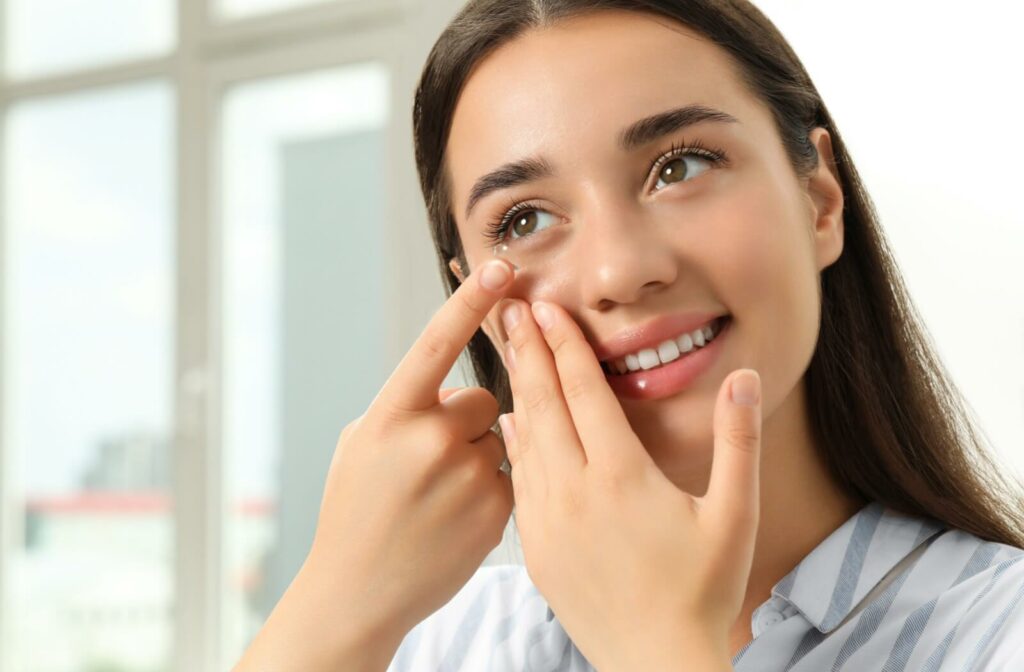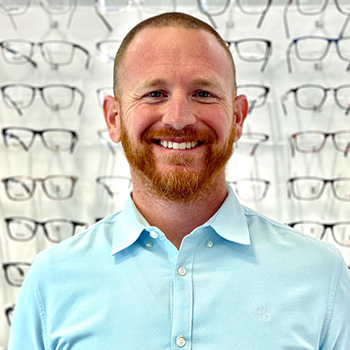That stinging, burning sensation in the eyes—it’s likely dry eye disease. This eye condition is a lot more common than most people think and can be extremely inconvenient to deal with. When the eyes are inflamed, everyday tasks like reading, driving, and especially putting in contact lenses can be more difficult. So can you wear contacts with dry eyes?
For people living with dry eyes, there is good news. With specialty options—like scleral or daily disposable soft lenses—many people can comfortably wear contacts designed to help with dry eyes.
What Is Dry Eye Disease?
Your tear film is an important part of your vision. It needs to properly protect the eye from the outside air, contaminants, bacteria, and more, all while acting as a clear and smooth shield to let light through.
To properly function, this tear film needs three layers:
- Mucus, to keep the tear securely attached to the eyelid
- Water, to flush away contaminating particles and hydrate the eye
- Oils, to prevent the tear itself from evaporating too quickly
When there’s an imbalance in the tear film, your tear film starts struggling to do its job. It may evaporate too quickly, or simply not have enough materials to make enough tears. This leaves the eye exposed to the outside air and easily irritated, quickly causing the sensation that the eyes are dried out and burning. This condition is called dry eye disease.
The Symptoms of Dry Eye Disease
Dry eye disease is easily recognizable by a constant stinging, burning, and inflamed feeling throughout the eyes. It can feel like there’s something trapped under your eyelid, or like your eye is constantly scratching against something small. These feelings can quickly lead to:
- Stringy mucus around the eyes
- Visible redness
- Increased irritation from smoke or wind
- Eye fatigue
- Headaches
- Overall inflammation and irritation
But it isn’t just about temporary discomfort. Dry eye disease makes it significantly more difficult to wear contact lenses, which can be extremely inconvenient for people relying on them for clear vision.
Plus, dry eye disease leaves your eyes exposed and vulnerable, making it more difficult to flush away potential contaminants and harmful bacteria. This can lead to an increased risk of scratches, infections, and more—and this can have a long-term effect on your vision.
Are There Contacts for Dry Eye?
With dry eye disease, regular contact lenses quickly become uncomfortable. Because they come into direct contact with the surface of your eye, they’ll often make the irritation and inflammation worse.
Fortunately, your optometrist may be able to help. There are specialty contact lenses designed to be worn with dry eyes, such as:
- Scleral lenses, which rest on the whites of the eyes and arch over the cornea, creating a small reservoir so the tears can’t drain away quickly
- Daily disposable lenses, which are only worn once and then thrown away, so there’s no buildup of irritants
- Moisture-retaining lenses, which help your eye retain its natural moisture while wearing contacts
Your optometrist will be able to assess your tear film to find out what contact is right for you. Remember—everyone’s eyes are unique, so letting a professional help is ideal.

How to Treat Dry Eyes
If you’re dealing with dry eyes, it’s crucial to seek treatment. It’s not just about comfort—it’s about lowering the risk of long-term damage to your eyes and vision.
At Dr. Bittel Optometry, we believe in a well-rounded approach. While specialty contacts can help you find relief, they can’t address the underlying cause of your dry eyes. When you visit our clinic, we’ll likely recommend one of the following types of dry eye rejuvenation to help you find long-lasting relief.
LipiFlow for Dry Eye
Dry eye disease is often caused by a problem with the meibomian glands—the dozens of tiny glands running through your eyelids that create oils for your tears.
With LipiFlow, your optometrist can use gentle amounts of heat and pressure to warm and unclog these glands, restoring the natural flow of oils to the tear film. It’s a non-invasive and relaxing procedure where you can simply sit back while the optometrist works. It only takes a few minutes, and many people find almost immediate relief!
IPL for Dry Eye
Intense pulsed light (IPL) therapy is another treatment aiming to target the root cause of your dry eye disease. With IPL, gentle levels of light-based heat are applied to the eyelids, warming the meibomian glands and stimulating the surrounding area.
This helps reduce the inflammation while breaking up any blockages in the glands. IPL usually only takes about 10-15 minutes or so, with significant improvements after a few sessions.
Envision by Inmode
Envision by Inmode is another innovative and non-invasive treatment. With Envision, a small applicator is used to apply radiofrequency waves to the area around the eyes. This helps to stimulate the meibomian glands and remove the oil blockages while improving your overall tear production.
This gentle but effective approach is extremely precise, and usually only takes a few minutes.
Try Dry Eye Rejuvenation Today
When living with dry eyes, every day can be frustrating. But it doesn’t have to be! Our team here at Dr. Bittle Optometry can help you find relief through dry eye rejuvenation. Whether specialty contacts or in-office treatment are the right choice for you, we’re here to help. Book an appointment with us today!


